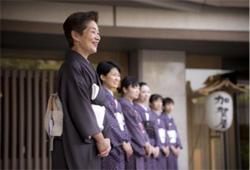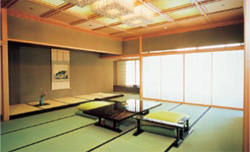Home > Highlighting JAPAN > Highlighting Japan JANUARY 2011 > Ryokan Comforts
Highlighting JAPAN
COVER STORY: The Spirit of Hospitality
Ryokan Comforts
The Kagaya spa and ryokan inn in Ishikawa Prefecture is one of the most famous in all Japan, renowned in particular for its outstanding hospitality. Yoko Matsui discovers the inn's secrets.

Suite attendants at Kagaya line up to welcome their guests.
Credit: COURTESY OF KAGAYA
"Among hotels, the Ritz-Carlton is famous for its hospitality," says Masao Torimoto, managing director of Kagaya. "At hotels, though, the several employees serve guests in their own special capacity as porter, concierge or maid. At ryokan, by contrast, one female employee known as a kyakushitsu-gakari, or suite attendant, is assigned to the guests occupying a suite and provides all the services they require during the length of their stay. We go to great lengths in this regard."
When showing guests to their room, for example, the suite attendant takes note of each guest's body size and prepares exactly the right sized yukata robes for each. In making small talk about the foods of the season or the local sights, she will casually discover the guests' preferences or their schedule for the next day so she can determine any way she might enhance their convenience. If they are celebrating a special occasion, such as a wedding anniversary or birthday, the attendant might bring a small gift or contact the kitchen to order a special treat. In the case of foreign guests, she may increase portion sizes at meals or vary the condiments to suit the customs of the guests' home country. Kagaya's method involves attentiveness and consideration rather than surprise.
"The attendant doesn't need permission from her superiors to provide special services," says Torimoto. "She's the one in direct contact with guests, so she's in the best position to determine their needs. Everything is left to her judgment."
There is, of course, a manual. Over the course of a month after joining Kagaya, employees are given extensive training on such things as how deeply to bow and how to prepare tea.
"But all that only delivers a 'C' grade, even if performed to the letter. Precision is essential, of course, but it's the education of the heart that's most important. Someone who's unable to empathize with another person can't work as a suite attendant. Hospitality begins from a sincere heart."

This luxury suite in Kagaya combines Japanese-style sophistication including arts, crafts and a garden with western-style comfort in the lounge and bedroom.
Credit: COURTESY OF KAGAYA
"For the evening meal, Kagaya serves kaiseki ryori, which is a set meal with many dishes served on a tray. Serving dishes such as broiled fish or deep-fried foods while they're still hot meant that dishes had to be carried back and forth three to four times. This was an immense burden for attendants before the process was automated. That made it possible to increase the time attendants could spend serving guests, and we believe it enhanced the quality of our hospitality."
In order to improve service even further, Kagaya has made increasing use of information technology in its accounting and other office processing with a view to increasing the efficiency of operations hidden from the eyes of guests. Kagaya also established a childcare center near the ryokan in 1986 so employees could work with peace of mind while caring for their children.
"A suite attendant's working hours extend from the afternoon that guests check in through the morning they check out the following day," says Torimoto. "This overlaps the time when children are at home. If an attendant is worried about her children, she can't present a sincere smile when interacting with guests."
The "best hospitality in Japan" has been realized through a philosophy whereby the whole company supports the suite attendant, who is the face of Kagaya. Torimoto nevertheless says Kagaya must be ready to consider varying its present service style.
"Lifestyles popular among Japanese change, and it doesn't follow that guests will always want the same traditional ryokan hospitality," explains Torimoto. "The means of conveying hospitality may change, even if people's hearts don't."
What, then, is the heart of Kagaya?
"A ryokan is like a home, you know. We're always thinking about how we can make guests feel more comfortable when they visit our home. The company creates an environment in which all employees can work easily, including the suite attendants. The employees, for their part, perform their jobs to make a better and better company. I think our faithfulness to this company spirit has been a factor in creating Kagaya's strong reputation."
As suite attendants discover new ways to serve in the course of their day-to-day contact with guests, Kagaya's hospitality will continue to evolve.
© 2009 Cabinet Office, Government of Japan






